Creating Project Browser Folders
I had an email today from a reader asking how to create custom folders in the Revit Project Browser. You can do this by customizing the browser organization and including a custom parameter. I thought that I would go ahead and post the steps here instead of just replying privately.
The first thing you want to do is decide how you will apply this custom parameter. It can be a Project Parameter or a Shared Parameter. There are arguments to made in favor of both approaches. In the steps that follow I am showing it using a simple Project Parameter. This means that we do not need to bother with the shared parameter setup. But if you already have a shared parameter file and prefer to do it that way, just choose the shared parameter radio button at the top instead of project parameter. The rest of the steps would be the same.
If you always want to use this organization in your projects, save this in your office standard project template file. That way all new projects will already have the custom parameter. Let’s get started:
- On the Manage tab, click the Project Parameters button.
- In the “Project Parameters” dialog, click the Add button.
- In the “Parameter Properties” dialog, choose the kind of parameter at the top (I chose Project Parameter for this example, but as noted, you can choose Shared Parameter instead if you wish).
- Type in a name such as: “Sheet Folder”
- Change the Type of Parameter to Text.
- On the right side, from the Categories list, check the Sheets box.
- Click OK twice.
The parameter is now ready. Next, you create some sheets and apply this new value to them.
- Create some sheets. (or work with existing ones)
- Select one or more sheets and then on the Properties palette, locate the new Sheet Folder parameter and type in a value such as: “Plumbing” and apply it.
- Repeat for all the sheets.
Now we will create the custom browser organization. You can find this command on the View tab, on the User Interface drop-down.
- On the View tab, click the User Interface drop-down and choose Browser Organization.
- Click the Sheets tab and then click the New button.
- Give it a name and then click OK.
- In the “Browser Organization Properties” dialog, on the Folders tab, choose the new custom Sheet Folder property for the first Group by item.
- If you wish, you can choose additional Group by criteria such as Sheet Number.
- For Sheet Number, you can even tell it to only use the first few characters by choosing the “Leading Characters” radio button and then setting it to a number such as 4. (this will display only the first four characters of the value – sheet number in this case).
- Click OK.
- Check the box next to the new sort to make it active and click OK to see the result on the Project Browser.
That’s it. You can do other customizations if you like, but that is the basic process. The only thing to be aware of is that since this is a custom parameter, Revit will not know about it and assign values automatically. In other words, each new sheet that you create must be assigned to a Sheet Folder or else you will see the ??? group in your browser and the unassigned sheets will appear there. Hope that this tutorial is useful.
34 Responses to Creating Project Browser Folders
Comments are closed.
Categories
- Off Topic (1)
- Project Soane (2)
- BIM After Dark (Revit Kid) (2)
- Tips and Tricks (29)
- Oddities (5)
- Book News (23)
- Video Training News (7)
- Speaking Engagements (5)
- Renaissance Revit (12)
- Off Topic (8)
- Revit Concepts (1)
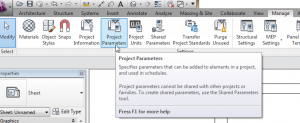
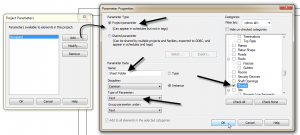
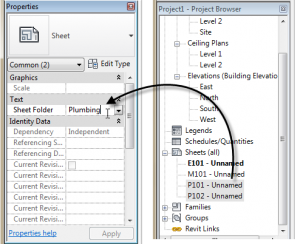
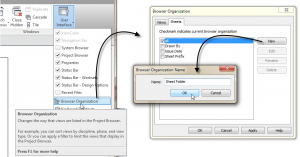
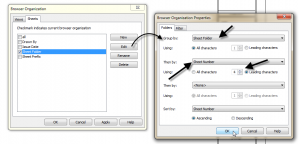
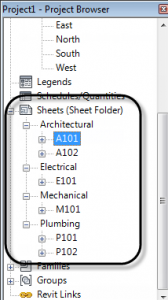
Thank you Paul
Been trying to figure that out for a few hours.
……and you managed to do it in a few minutes.
Your book is on order, just tell me where I can find it.
Thank you so much.
My pleasure. Glad to help. You can find out more about ordering my books on the book pages here.
Fantastic, nice clear explanation. I’ll be using it to set up user views so people can have their own ‘workbench’ of views to navigate the model. Cheers.
Thanks very much. Glad you found it useful.
The beautiful thing about this is if you already have a parameter set-up for your sheets to divide by discipline for a drawing index you can just reference that same parameter and skip having to spend time re-typing what is already entered on each sheet.
Great little tutorial Paul, and I love your book. It never leaves my desk, not even for fellow worker to barrow, they have to look at at my desk!
Thanks Tom! Very nice comment and much appreciated.
Paul, can you do the same thing for schedules?
No unfortunately not. This only works for Views and Sheets.
Is it possible to create further subdivisions within views? For instance, I have a group of detail drawings (drafting views) that I want to keep under one heading “Project standards” and then I want to divide that further into categories like doors, windows, floors, equipment etc. Then some of those have several parts that I want to keep grouped on one drawing but I can edit individually. For instance under “doors” I have head and jamb details, and there are several of them, and I want to draw them separately but keep them together. Is all of this possible?
* but without causing all of my other views to require the same organization or categorization.
You can add more than one custom parameter. Then you can set up multiple hierarchical sorts. However, you cannot do this for only one group. So unfortunately if you add it to one, you add it to all. Sorry.
This all was great, except toward the bottom you say:
“In the ???Browser Organization Properties??? dialog, on the Folders tab, choose the new custom Sheet Folder property for the first Group by item.”
I don’t have a “Folders” tab in the Browser Organization and Sorting dialog, only Filtering, and Grouping and Sorting.
When I filter by the new entry, it displays ok with the correct sheets under its heading, but the other (previous sheets not in that category) are under a heading “???”.
Seems like I’m missing something? Thanks for any help
Revit Architecture 2014
Hello:
So you must be on Revit 2014. They changed this dialog in 2014. The Folders tab has become the “Grouping and Sorting” tab and it now has more sort criteria. Otherwise it should work the same as before.
Ok, so I see at the bottom there you note that any unassigned sheets end up in the ??? folder… but I can only seem to get one custom folder to appear at a time (or one and the ??? folder).
I’m trying to make a folder sort for A-Sized sheets, and D-sized sheets in the project. I can get either A, or D to show in the project browser, but not both. Seems like a filtering issue… but I can’t find that Folders tab you mention? I think that’s my missing piece.
JP
All of these group and sort criteria are just queries of your list of sheets. Do you have both an A and D size sheet in your project? If you just change back and forth, it will only show the current one. Make sure you have at least two sheets in the project, one set to A and one set to D. That should do the trick.
Is there a way to create another level of organization within the newly created Folder, without the Project Browser showing the subfolder?
For example, I’m trying to arrange “T”, “G” and “A” sheets all within the “Architecture” folder (which currently it arranges by alphabetical order). I’ve tried creating other parameters, but then those show up as folders and then my sheets in those folder:
Architecture (Sheet Folder)
0 (Sublevel)
T101
1 (Sublevel)
G101
G102
2 (Sublevel)
A101
A102
Is it possible to organize it so it looks more like:
Architecture (Sheet Folder)
T101
G101
G102
A101
A102
Gene D
Hi Gene:
I’m afraid that there is no way to make the browser look the way you are asking. If you want it sorted non-alpha, you will have to be content with the extra sub-branches. However, you can hide this field in your sheet index. So your sheet index can look the way you like, just not the browser.
Hope that helps.
I’d do nothing without your posts!
Thanks.
However,
i come up with a very big problem for me today. i create a template file but i can’t load it when i want to create a new project. i simply do that new>project>i choose the template file>i tick create project part but it acts like i don’t choose anything, i can’t see anything from the template even it ask if it will be metric or imperial. So i think it’s a license problem, we’ve upgraded the version from 2012 to 2103.
With another computer it works perfectly fine.
We’ll contact with our IT specialist and Autodesk support team but i wonder do you have any idea what else could it be.
Thank you very much for all your work.
That is an odd sounding issue. If it works fine on another computer, then it is likely something wrong with the install. You should check to see if you can open and create other project (from a different template) on that machine. This would indicate an issue with the template, but since you can open it on another computer, I am not sure that is it. Unless you have copied the template to the other computer? Then maybe try copying it again.
It was an installation problem i understand. IT person did the setup but i guess he didn’t select some features. So i solve it now from the program menu, i update the installation by Add/Remove features. I checked UK, US imperial, US metric . It takes a time like 15 min. and it works now.
So if i am not wrong the content is necessary for the program to recognize your template or anything about it.
It does act weird without the content sometime. Glad you figured it out.
Hi Paul:
How do you add a subfolder to the Sheets(FOLDER)? I currently have 5 subfolder in it, but forgot how to add a new one?
Thank you
Susan
Hello Susan:
You just type it in. Click in the field on the Properties palette and type in whatever you like. When you press ENTER it will add to the list.
Hope that helps.
Hi Paul,
I’m having the opposite issue.
How can I remove one of those folder categories? The List is getting long and we have finally settled on how we want to call the folders.
Hello:
To remove one of the entries, you have to make sure that no views are using that value. So simply select any view that uses the value you want to eliminate and change it to some other value instead. When you have removed the last instance, the unwanted value will disappear from the list as well. The drop-down list only shows values currently in use and dynamically updates.
Hope that helps.
Paul,
I see that you said this can only be done for sheets and views, which I have done before and set up our office template accordingly. But thought I would ask anyway. Our office would like to create a new subcategory under Families; Walls for a “short” list of our most used walls so staff doesn’t have to look under the fairly long list of walls we currently have listed under Basic Wall. We use them all in our projects but would like a subcategory to be able to reference the shorter most used list. Thank you for your reply.
Hello Bruce:
Sorry. You can only add custom browser organization to the Views and Sheets branches. Best you can do with your list of walls is name them with a prefix to force the ones you use frequently to the top. Something like the underscore _Wall 1, _Wall 2, etc is pretty popular.
Hope that helps.
[…] Creating Project Browser Folders […]
it’s possible to see all the sheet of the RVT links in the project browser?
Afraid not. Sorry.
Hi Paul,
Your methodology was very helpful but I have a question; how do you delete or change a sub folder name. For some reason I managed to create a sub folder which bears the same name, one which I created using your method and another to which I don’t know how, it was a trial and error process. My folders are not exactly how I would like them and it would be useful to know the procedure for making changes etc
Thanks in advance
Peter
Hello:
You must be very careful when using shared parameters. If you do not do it correctly, you can end up with multiple parameters bearing the same name. So I suspect that this is what happened in your case. I would remove all of the parameters except one of them. And then if you have multiple shared parameter files, you want to eliminate all but one. There are tools that you can download that will help you merge shared parameter files. CTC Software has one for example.
Also consider that while the approach I outline here is popular in many firms, there are many ways to organize your browser that do not require shared or custom parameters. Try using view types (including custom view types) and View Templates. These are both nice alternatives and have the extra benefit of avoiding the ??? folder.